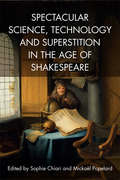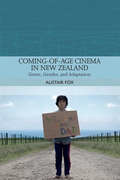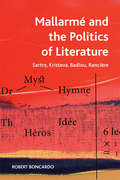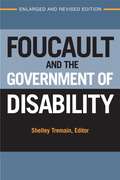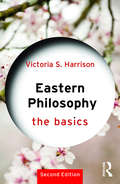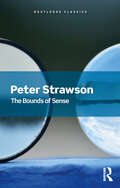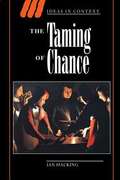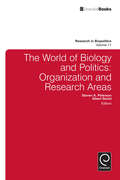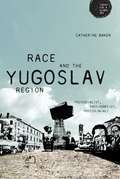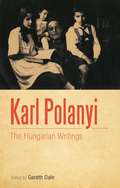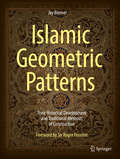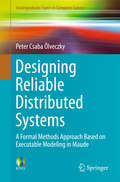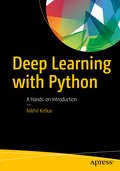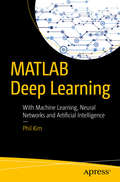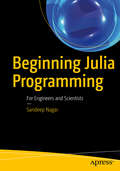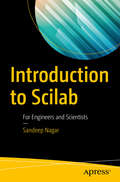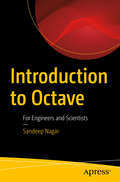- Table View
- List View
Spectacular Science, Technology and Superstition in the Age of Shakespeare
by Sophie Chiari Mickaël PopelardHow can multicultural governance respond to our increasingly complex migratory world?
Coming-of-Age Cinema in New Zealand: Genre, Gender and Adaptation in a National Cinema (Traditions In World Cinema Ser.)
by Alistair FoxExplores the complex ethical dilemmas of human mobility in the context of climate change
Mallarme and the Politics of Literature: Sartre, Kristeva, Badiou, Rancière
by Robert BoncardoA radically new philosophy of experience and speculation, based on a reading of Whitehead’s Process and Reality
Pina Bausch's Dance Theatre: Tracing the Evolution of Tanztheater (Edinburgh Critical Studies In Modernism Drama And Performance Ser.)
by Lucy WeirRethinks how psychoanalysis, political thought and philosophy can be brought together as acts of resistance
Scottish Education: Fifth Edition
by T. G. K. Bryce W. M. HumesInterrogates the rise of national philosophies and their impact on cosmopolitanism and nationalism
Foucault And The Government Of Disability (PDF)
by Shelley Lynn TremainThis revised and expanded edition of Foucault and the Government of Disability considers the continued relevance of Foucault to disability studies, as well as the growing significance of disability studies to understandings of Foucault. A decade ago, this international collection provocatively responded to Foucault’s call to question what is regarded as natural, inevitable, ethical, and liberating. The book’s contributors draw on Foucault to scrutinize a range of widely endorsed practices and ideas surrounding disability, including rehabilitation, community care, impairment, normality and abnormality, inclusion, prevention, accommodation, and special education. Now, four new essays extend and elaborate the lines of inquiry by problematizing (to use Foucault’s term) the epistemological, political, and ethical character of the supercrip,the racialized war on autism, the performativity of intellectual disability, and the potent mixture of neoliberalism and biopolitics in the context of physician-assisted suicide.
Eastern Philosophy: The Basics (The Basics)
by Victoria S. HarrisonEastern Philosophy: The Basics is an essential introduction to major Indian and Chinese philosophies, both past and present. Exploring familiar metaphysical and ethical questions from the perspectives offered by a range of eastern philosophies, including Confucianism, Daoism, the main Buddhist and Hindu philosophical schools, as well as Jainism, this book covers key figures, issues, methods and concepts. Questions discussed include: What is the ‘self’? Is human nature inherently good or bad? How is the mind related to the world? How can you live an authentic life? What is the fundamental nature of reality? With timelines highlighting key figures and their contributions, a list of useful websites, pronunciation guides and further reading suggestions, Eastern Philosophy: The Basics provides an engaging overview of fundamental ideas in eastern philosophy. The second edition has been thoroughly revised and updated to take account of the most recent scholarship. It includes study questions for each chapter, an updated bibliography, a new section on the Yijing and expanded discussion of Indian philosophies and their basis in experience. Eastern Philosophy: The Basics is valuable reading for all students of philosophy and religion, especially those seeking to understand eastern thought.
Atheism: The Basics (The Basics)
by Graham OppyAtheism: The Basics is a concise and engaging introduction to belief in the non-existence of deities. Atheism has long fascinated people but debate around this controversial position may seem daunting. In this lively and lucid book, Graham Oppy addresses the following important questions: • What does it mean to be an atheist? • What is the difference between atheism, agnosticism, theism and innocence? • How has atheism been distributed over time and place? • What does science tell us about atheism? • Are there good reasons to be an atheist? • Are there good reasons not to be an atheist? • What do we mean by ‘new atheism'? With a glossary of key terms and suggestions for further reading throughout, the book considers key philosophical arguments around atheism, making this an ideal starting point for anyone seeking a full introduction to the arguments between those who hold atheistic beliefs and those who do not.
The Bounds of Sense: An Essay on Kant’s Critique of Pure Reason (Routledge Classics)
by Peter StrawsonPeter Strawson (1919–2006) was one of the leading British philosophers of his generation and an influential figure in a golden age for British philosophy between 1950 and 1970. The Bounds of Sense is one of the most influential books ever written about Kant’s philosophy, and is one of the key philosophical works of the late twentieth century. Whilst probably best known for its criticism of Kant’s transcendental idealism, it is also famous for the highly original manner in which Strawson defended and developed some of Kant’s fundamental insights into the nature of subjectivity, experience and knowledge – at a time when few philosphers were engaging with Kant’s ideas. The book had a profound effect on the interpretation of Kant’s philosophy when it was first published in 1966 and continues to influence discussion of Kant, the soundness of transcendental arguments, and debates in epistemology and metaphysics generally. This Routledge Classics edition includes a new foreword by Lucy Allais.
The Taming of Chance (PDF)
by Ian HackingIn this important study Ian Hacking continues the enquiry into the origins and development of certain characteristic modes of contemporary thought undertaken in such previous works as the best-selling The Emergence of Probability. Professor Hacking shows how by the late-nineteenth century it became possible to think of statistical patterns as explanatory in themselves, and to regard the world as not necessarily deterministic in character. In the same period the idea of human nature was displaced by a model of normal people with laws of dispersion. These two parallel transformations fed into each other, so that chance made the world seem less capricious: it was legitimated because it brought order out of chaos. Combining detailed scientific historical research with characteristic philosophic breadth and verve, The Taming of Chance brings out the relations between philosophy, the physical sciences, mathematics and the development of social institutions, and provides a unique and authoritative analysis of the 'probabilisation' of the western world.
The World of Biology and Politics: Organization And Research Areas (Research in Biopolitics #11)
by Steven A. Peterson Albert SomitThis volume describes (a) the present academic and institutional status of Biopolitics and (b) the wide range of research areas that have emerged within the field. The Introduction puts into perspective the major differences and similarities between Biopolitics and more traditional approaches to political science in terms of basic concepts, scope, research methodology, and the resulting implications for public policy. The next two chapters focus on the institutions and organizations that have significantly influenced the structure and direction of the "movement." Chapter 4 describes how and why evolutionary theory has had an increasingly influential impact on political science. Chapters 5 through 9 are "case studies" of how biological perspectives have been productively used in several of the discipline's established "fields." Chapter 10 is a measured critical analysis of the enterprise and Chapter 11 looks at where biopolitics as a field might be moving.
Antisemitism and the left: On the return of the Jewish question
by Robert Fine Philip SpencerA highly original conceptual study of the opposing faces of universalism, its stimulation for Jewish emancipation and the struggle for its rescue from repressive, antisemitic associations.
Democratic inclusion: Rainer Bauböck in dialogue (Critical Powers Ser.)
by Rainer BauböckLeading scholar of citizenship and migration Rainer Bauböck proposes a theory of inclusion for democratic societies. Five prominent interlocutors comment on this theory.
Cultivating political and public identity: Why plumage matters (Manchester University Press Ser. (PDF))
by Rodney BarkerThis bold and original study looks at the performance of identity in the public sphere, using the concept of 'plumage' to capture the countless elements that go together to make up a shared identity.
Race and the Yugoslav region: Postsocialist, post-conflict, postcolonial?
by Catherine BakerThis study argues that, contrary to many assumptions, Yugoslavia and its successor states are deeply embedded in the global history and politics of ‘race’, and that the ambiguities of perceiving ‘race’ in the region’s past and present in fact have complex historical roots.
Karl Polanyi: The Hungarian writings
by Gareth DaleThis is the first work to offer a collection of Polanyi's texts never before published in English. The book presents articles, papers, lectures, speeches, notes, and draft manuscripts, mostly written between 1907 and 1923, with the exception of a few later texts. Organised thematically around religion, ethics, ideology, world politics and Hungarian politics, the topics include contemporary thinkers, the Galilei Circle, the Tisza government, the Aster and the Bolshevik Revolutions, the Councils Republic, the Radical Citizens' Party, Hungarian democracy, the national question, political conviction, fatalism, British socialism, political theory and violence, and more. Each section includes a discussion of the political and intellectual contexts in which the texts were written. Karl Polanyi: The Hungarian writings is an outstanding and essential resource that brings to light for the first time the works of a key thinker who is relevant to today's study of globalisation, neoliberalism, social movements, and international social policy.
I Drink Therefore I Am: A Philosopher's Guide to Wine
by Sir Roger ScrutonWe are familiar with the medical opinion that a daily glass of wine is good for the health and also the rival opinion that any more than a glass or two will set us on the road to ruin. Whether or not good for the body, Scruton argues, wine, drunk in the right frame of mind, is definitely good for the soul. And there is no better accompaniment to wine than philosophy. By thinking with wine, you can learn not only to drink in thoughts but to think in draughts.This good-humoured book offers an antidote to the pretentious clap-trap that is written about wine today and a profound apology for the drink on which civilisation has been founded.In vino veritas.
Islamic Geometric Patterns: Their Historical Development and Traditional Methods of Construction
by Jay Bonner Craig KaplanThe main focus of this unique book is an in-depth examination of the polygonal technique; the primary method used by master artists of the past in creating Islamic geometric patterns. The author details the design methodology responsible for this all-but-lost art form and presents evidence for its use from the historical record, both of which are vital contributions to the understanding of this ornamental tradition. Additionally, the author examines the historical development of Islamic geometric patterns, the significance of geometric design within the broader context of Islamic ornament as a whole, the formative role that geometry plays throughout the Islamic ornamental arts (including calligraphy, the floral idiom, dome decoration, geometric patterns, and more), and the underexamined question of pattern classification.Featuring over 600 beautiful color images, Islamic Geometric Patterns: Their Historical Development and Traditional Methods of Construction is a valuable addition to the literature of Islamic art, architecture and geometric patterns. This book is ideal for students and scholars of geometry, the history of mathematics, and the history of Islamic art, architecture, and culture. In addition, artists, designers, craftspeople, and architects will all find this book an exceptionally informative and useful asset in their fields.Jay Bonner is an architectural ornamentalist and unaffiliated scholar of Islamic geometric design. He received his MDes from the Royal College of Art in London (1983). He has contributed ornamental designs for many international architectural projects, including the expansion of both the al-Masjid al-Haram (Grand Mosque) in Mecca, and the al-Masjid an Nawabi (Prophet’s Mosque) in Medina, as well the Tomb of Sheikh Hujwiri in Lahore, and the Ismaili Centre in London – to name but a few. He is committed to the revitalization of Islamic geometric design through the teaching of traditional methodological practices. To this end, in addition to publishing, Jay Bonner has lectured and taught design seminars at many universities and conferences in North America, Europe, North Africa and Asia.
Designing Reliable Distributed Systems: A Formal Methods Approach Based on Executable Modeling in Maude (Undergraduate Topics in Computer Science)
by Peter Csaba ÖlveczkyThis classroom-tested textbook provides an accessible introduction to the design, formal modeling, and analysis of distributed computer systems. The book uses Maude, a rewriting logic-based language and simulation and model checking tool, which offers a simple and intuitive modeling formalism that is suitable for modeling distributed systems in an attractive object-oriented and functional programming style.Topics and features: introduces classical algebraic specification and term rewriting theory, including reasoning about termination, confluence, and equational properties; covers object-oriented modeling of distributed systems using rewriting logic, as well as temporal logic to specify requirements that a system should satisfy; provides a range of examples and case studies from different domains, to help the reader to develop an intuitive understanding of distributed systems and their design challenges; examples include classic distributed systems such as transport protocols, cryptographic protocols, and distributed transactions, leader election, and mutual execution algorithms; contains a wealth of exercises, including larger exercises suitable for course projects, and supplies executable code and supplementary material at an associated website.This self-contained textbook is designed to support undergraduate courses on formal methods and distributed systems, and will prove invaluable to any student seeking a reader-friendly introduction to formal specification, logics and inference systems, and automated model checking techniques.
The Age of Genius: The Seventeenth Century and the Birth of the Modern Mind
by Professor A. C. GraylingWhat happened to the European mind between 1605, when an audience watching Macbeth at the Globe might believe that regicide was such an aberration of the natural order that ghosts could burst from the ground, and 1649, when a large crowd, perhaps including some who had seen Macbeth forty-four years earlier, could stand and watch the execution of a king? Or consider the difference between a magus casting a star chart and the day in 1639, when Jonathan Horrock and William Crabtree watched the transit of Venus across the face of the sun from their attic, successfully testing its course against Kepler's Tables of Planetary Motion, in a classic case of confirming a scientific theory by empirical testing.In this turbulent period, science moved from the alchemy and astrology of John Dee to the painstaking observation and astronomy of Galileo, from the classicism of Aristotle, still favoured by the Church, to the evidence-based, collegiate investigation of Francis Bacon. And if the old ways still lingered and affected the new mind set – Descartes's dualism an attempt to square the new philosophy with religious belief; Newton, the man who understood gravity and the laws of motion, still fascinated to the end of his life by alchemy – by the end of that tumultuous century 'the greatest ever change in the mental outlook of humanity' had irrevocably taken place.
Deep Learning with Python: A Hands-on Introduction
by Nikhil KetkarDiscover the practical aspects of implementing deep-learning solutions using the rich Python ecosystem. This book bridges the gap between the academic state-of-the-art and the industry state-of-the-practice by introducing you to deep learning frameworks such as Keras, Theano, and Caffe. The practicalities of these frameworks is often acquired by practitioners by reading source code, manuals, and posting questions on community forums, which tends to be a slow and a painful process. Deep Learning with Python allows you to ramp up to such practical know-how in a short period of time and focus more on the domain, models, and algorithms.This book briefly covers the mathematical prerequisites and fundamentals of deep learning, making this book a good starting point for software developers who want to get started in deep learning. A brief survey of deep learning architectures is also included.Deep Learning with Python also introduces you to key concepts of automatic differentiation and GPU computation which, while not central to deep learning, are critical when it comes to conducting large scale experiments. What You Will Learn Leverage deep learning frameworks in Python namely, Keras, Theano, and Caffe Gain the fundamentals of deep learning with mathematical prerequisites Discover the practical considerations of large scale experiments Take deep learning models to productionWho This Book Is ForSoftware developers who want to try out deep learning as a practical solution to a particular problem. Software developers in a data science team who want to take deep learning models developed by data scientists to production.
MATLAB Deep Learning: With Machine Learning, Neural Networks and Artificial Intelligence
by Phil KimGet started with MATLAB for deep learning and AI with this in-depth primer. In this book, you start with machine learning fundamentals, then move on to neural networks, deep learning, and then convolutional neural networks. In a blend of fundamentals and applications, MATLAB Deep Learning employs MATLAB as the underlying programming language and tool for the examples and case studies in this book. With this book, you'll be able to tackle some of today's real world big data, smart bots, and other complex data problems. You’ll see how deep learning is a complex and more intelligent aspect of machine learning for modern smart data analysis and usage.What You'll LearnUse MATLAB for deep learningDiscover neural networks and multi-layer neural networksWork with convolution and pooling layersBuild a MNIST example with these layersWho This Book Is ForThose who want to learn deep learning using MATLAB. Some MATLAB experience may be useful.
Beginning Julia Programming: For Engineers and Scientists
by Sandeep NagarGet started with Julia for engineering and numerical computing, especially data science, machine learning, and scientific computing applications. This book explains how Julia provides the functionality, ease-of-use and intuitive syntax of R, Python, MATLAB, SAS, or Stata combined with the speed, capacity, and performance of C, C++, or Java. You’ll learn the OOP principles required to get you started, then how to do basic mathematics with Julia. Other core functionality of Julia that you’ll cover, includes working with complex numbers, rational and irrational numbers, rings, and fields. Beginning Julia Programming takes you beyond these basics to harness Julia’s powerful features for mathematical functions in Julia, arrays for matrix operations, plotting, and more. Along the way, you also learn how to manage strings, write functions, work with control flows, and carry out I/O to implement and leverage the mathematics needed for your data science and analysis projects."Julia walks like Python and runs like C". This phrase explains why Julia is quickly growing as the most favored option for data analytics and numerical computation. After reading and using this book, you'll have the essential knowledge and skills to build your first Julia-based application. What You'll LearnObtain core skills in Julia Apply Julia in engineering and science applicationsWork with mathematical functions in Julia Use arrays, strings, functions, control flow, and I/O in JuliaCarry out plotting and display basic graphics Who This Book Is ForThose who are new to Julia; experienced users may also find this helpful as a reference.
Introduction to Scilab: For Engineers and Scientists
by Sandeep NagarFamiliarize yourself with Scilab using this concise, practical tutorial that is focused on writing code to learn concepts. Starting from the basics, this book covers array-based computing, plotting, and working with files in Scilab. Introduction to Scilab is useful for industry engineers, researchers, and students who are looking for open-source solutions for numerical computation.In this book you will learn by doing, avoiding technical jargon, which makes the concepts easy to learn. First you’ll see how to run basic calculations, absorbing technical complexities incrementally as you progress toward advanced topics. Throughout, the language is kept simple to ensure that readers at all levels can grasp the concepts. After reading this book, you will come away with sample code that can be re-purposed and applied to your own projects using Scilab.What You'll LearnApply sample code to your engineering or science problemsWork with Scilab arrays, functions, and loops Use Scilab’s plotting functions for data visualizationSolve numerical computing and computational engineering problems with ScilabWho This Book Is ForEngineers, scientists, researchers, and students who are new to Scilab. Some prior programming experience would be helpful but not required.
Introduction to Octave: For Engineers and Scientists
by Sandeep NagarFamiliarize yourself with Octave using this concise, practical tutorial that is focused on writing code to learn concepts. Starting from the basics, this book covers array-based computing, plotting, and working with files in Octave, which can run MATLAB files without modification. Introduction to Octave is useful for industry engineers, researchers, and students who are looking for open-source solutions for numerical computation.In this book you will learn by doing, avoiding technical jargon, which makes the concepts easy to learn. First you’ll see how to run basic calculations, absorbing technical complexities incrementally as you progress toward advanced topics. Throughout, the language is kept simple to ensure that readers at all levels can grasp the concepts. What You'll LearnApply sample code to your engineering or science problemsWork with Octave arrays, functions, and loops Use Octave’s plotting functions for data visualizationSolve numerical computing and computational engineering problems with OctaveWho This Book Is ForEngineers, scientists, researchers, and students who are new to Octave. Some prior programming experience would be helpful but not required.
